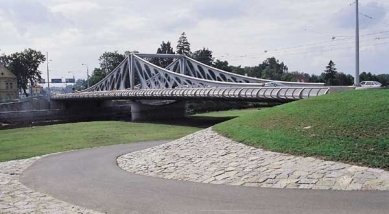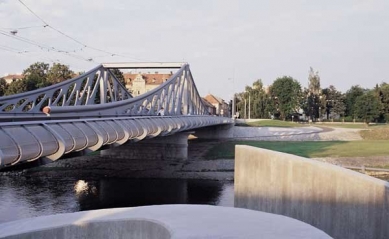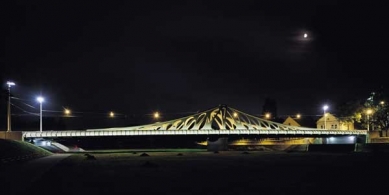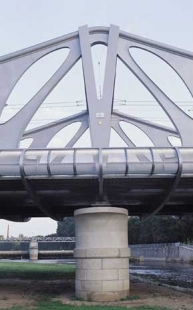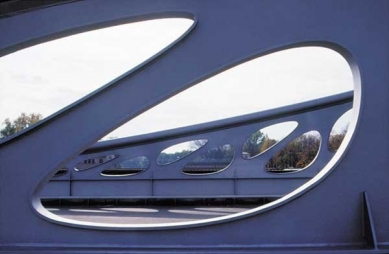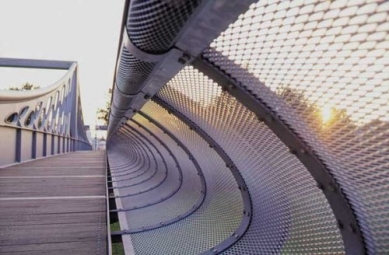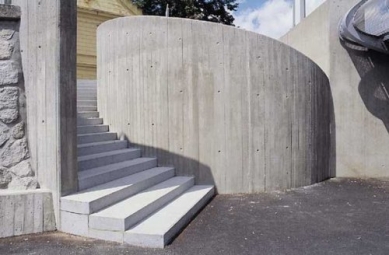
<Long bridge>

...we love celebrations. The Long Bridge seems to attract festivities. And changes too. It is almost unbelievable how many times it has changed its appearance, and not just superficially, but fundamentally. A crossing at the site of the Long Bridge has existed practically since the establishment of the Gothic town. Other cities have such places too: Prague, Písek, Louny, but here the bridges stand and remain standing. Judith's Bridge was replaced by Charles' Bridge, but nothing has followed since. Statues will be added, the roadway will be widened, but the bridges remain. And the Long Bridge? We find its first image on Miler's map from 1720. The wooden bridge from 1797 had nine supports over the river and another five on the left bank; a painting by Vojtěch Benedikt Juhn depicts the appearance of the bridge from 1809. According to a project from 1818, a 103.5 m long wooden bridge with five wooden supports in the river and two stone ones on the banks was built. The next bridge, which we know from a lithograph by Josef Hafner, had only two guiding pillars. The first steel bridge with stone pillars from 1880 was a truss bridge, while another from 1932 featured flat girders. What leads to the fact that the Long Bridge continues to change its face so dramatically? It certainly isn't mere function, as its dimensions don't increase significantly... Do mayors, roads, or the river desire change? Just as people are different, maybe places on Earth are different too. Somewhere there is absolute stability and no force can change the character of the place, and somewhere mountains change into valleys and vice versa. The Long Bridge is perhaps a place of changes. Or is the current form of the bridge already the last? Probably not. And yet the whole surrounding town behaves very "cautiously." It still turns towards its large square, even though in other similarly sized cities squares would have long since multiplied and the activity and energy of the town would have evenly distributed among them. The river, which in most large cities is very "urbanized" and regulated, is allowed to flow through its natural channel, with very little regulation. The structure does not change much either, and the inner ring road still describes a complex polygon of fencing. Inside the city, there are large undeveloped areas of parks and gardens. The city does not grow vertically either; its roofs are disproportionately low for such a large city...
The Long Bridge seems to be a pressure relief valve for this dozing, or rather dreaming city. As if the natural desire for changes, lurking somewhere deep within every society, occasionally breaks to the surface precisely at this place in the tranquil and balanced South Bohemia. Maybe it is so, and it is meant to be so. Just as the bridge itself changes and stages various theatrical performances against the backdrop of the city, it also attracts different events to itself. As early as 1835, when a procession with the imperial couple arrived in České Budějovice, a triumphal arch stood by the Long Bridge to welcome them. And when at the end of the 1920s the bridge once again changed its appearance, the builders decided to shift its old structure onto temporary supports so it could serve during the construction of the new bridge. The move took three days and it must have been quite a sight. Bridges are built and rebuilt, but moving them from place to place is not that common. And when at that time the new bridge was being riveted, the local press wrote about the "quirky song of pneumatic riveters..." and "the constant interest of the numerous populace." The appearance of the Long Bridge changes, but some events repeat themselves. In the brief for the previous bridge, it was "…to focus on the aesthetics of the bridge..." and the latest bridge was built based on the results of an architectural competition. The truss bridge was moved downstream of the Vltava, while we moved the old bridge upstream of the river. Stones from the supports during the previous reconstruction were used for the construction of new ones, and we also utilized existing stones for building new bank supports. The old structures of both previous bridges had the chance to continue serving in some shorter crossings, but neither succeeded. And if we can assume from period documents that the construction of the previous Long Bridge was a significant event for the town, we can confirm that this was definitely the case for this bridge. Already during the move, which lasted only a few hours compared to the previous one, so many people came to the embankment that after a while it was impossible to "defend" even the construction site surrounded by caution tape. People eagerly watched as small pneumatic pumps moved the massive bridge and whether in the end they would "land" on the prepared bearings of the temporary supports. And when six identical blue Tatras loaded with sand drove onto the bridge for a load test, slowly crossing closely side by side, it was an almost theatrical spectacle. Also, when the new bridge began to rise above the right bank, people came to watch its progress. The entire assembly was a performance. Above the right bank, the first part of the bridge from the left embankment began to appear, and with each additional piece, it approached its proper place along the transport path. At one point, the highest part of the bridge appeared above the right bank support and the left expansion joint over the central pillar. At that time, we also overheard a conversation between two boys who rode up on bikes to see what was happening on the bridge. A computer drawing of the future bridge hung on the boundary wall: “...look mate, those idiots are building the bridge backward...” We perceived it as the greatest possible proof of interest. The biggest celebration, however, took place on October 28, 1998. On the bridge and in the wide surroundings, there was no movement, majorettes, music, and an almost touching procession of old scouts with standards, foreign and domestic guests, and above all, thousands of people. Speeches, fanfares, cutting of ribbons, interviews with journalists. The placement and sealing of a stainless steel memorial capsule with period documents into the headpiece of the central pillar and in the evening, fireworks. A composed light show with the music of Smetana's Vltava. The evening later turned into a spontaneous disco on the banks of the Vltava. It was a celebration. People walked back and forth across the bridge, and on both banks, they made long colorful garlands that constantly changed and moved. The elongated lines of the Budějovice riverside parks are very charming, even though often neglected, because parks also logically could not escape the era of "building socialism." However, these parks have great potential. The river with their green backdrop is itself a scenery where many theatrical performances can take place and are taking place. The balanced flow of this blue-green strip is only occasionally disturbed by the intervention of human hands or the figure of a fisherman on the quay, a cyclist, or a resting clerk. The bridge, the power plant, the weir, the exhibition house, these are the accents on this path, the central motifs of the surrounding events. The lines of the upper curves of the bridge gently rise from the Vltava embankment to sound the highest tone above the river. The bridge is part of the city and part of the river; the Long Bridge is part of the celebration...
The Long Bridge seems to be a pressure relief valve for this dozing, or rather dreaming city. As if the natural desire for changes, lurking somewhere deep within every society, occasionally breaks to the surface precisely at this place in the tranquil and balanced South Bohemia. Maybe it is so, and it is meant to be so. Just as the bridge itself changes and stages various theatrical performances against the backdrop of the city, it also attracts different events to itself. As early as 1835, when a procession with the imperial couple arrived in České Budějovice, a triumphal arch stood by the Long Bridge to welcome them. And when at the end of the 1920s the bridge once again changed its appearance, the builders decided to shift its old structure onto temporary supports so it could serve during the construction of the new bridge. The move took three days and it must have been quite a sight. Bridges are built and rebuilt, but moving them from place to place is not that common. And when at that time the new bridge was being riveted, the local press wrote about the "quirky song of pneumatic riveters..." and "the constant interest of the numerous populace." The appearance of the Long Bridge changes, but some events repeat themselves. In the brief for the previous bridge, it was "…to focus on the aesthetics of the bridge..." and the latest bridge was built based on the results of an architectural competition. The truss bridge was moved downstream of the Vltava, while we moved the old bridge upstream of the river. Stones from the supports during the previous reconstruction were used for the construction of new ones, and we also utilized existing stones for building new bank supports. The old structures of both previous bridges had the chance to continue serving in some shorter crossings, but neither succeeded. And if we can assume from period documents that the construction of the previous Long Bridge was a significant event for the town, we can confirm that this was definitely the case for this bridge. Already during the move, which lasted only a few hours compared to the previous one, so many people came to the embankment that after a while it was impossible to "defend" even the construction site surrounded by caution tape. People eagerly watched as small pneumatic pumps moved the massive bridge and whether in the end they would "land" on the prepared bearings of the temporary supports. And when six identical blue Tatras loaded with sand drove onto the bridge for a load test, slowly crossing closely side by side, it was an almost theatrical spectacle. Also, when the new bridge began to rise above the right bank, people came to watch its progress. The entire assembly was a performance. Above the right bank, the first part of the bridge from the left embankment began to appear, and with each additional piece, it approached its proper place along the transport path. At one point, the highest part of the bridge appeared above the right bank support and the left expansion joint over the central pillar. At that time, we also overheard a conversation between two boys who rode up on bikes to see what was happening on the bridge. A computer drawing of the future bridge hung on the boundary wall: “...look mate, those idiots are building the bridge backward...” We perceived it as the greatest possible proof of interest. The biggest celebration, however, took place on October 28, 1998. On the bridge and in the wide surroundings, there was no movement, majorettes, music, and an almost touching procession of old scouts with standards, foreign and domestic guests, and above all, thousands of people. Speeches, fanfares, cutting of ribbons, interviews with journalists. The placement and sealing of a stainless steel memorial capsule with period documents into the headpiece of the central pillar and in the evening, fireworks. A composed light show with the music of Smetana's Vltava. The evening later turned into a spontaneous disco on the banks of the Vltava. It was a celebration. People walked back and forth across the bridge, and on both banks, they made long colorful garlands that constantly changed and moved. The elongated lines of the Budějovice riverside parks are very charming, even though often neglected, because parks also logically could not escape the era of "building socialism." However, these parks have great potential. The river with their green backdrop is itself a scenery where many theatrical performances can take place and are taking place. The balanced flow of this blue-green strip is only occasionally disturbed by the intervention of human hands or the figure of a fisherman on the quay, a cyclist, or a resting clerk. The bridge, the power plant, the weir, the exhibition house, these are the accents on this path, the central motifs of the surrounding events. The lines of the upper curves of the bridge gently rise from the Vltava embankment to sound the highest tone above the river. The bridge is part of the city and part of the river; the Long Bridge is part of the celebration...
The English translation is powered by AI tool. Switch to Czech to view the original text source.
0 comments
add comment


